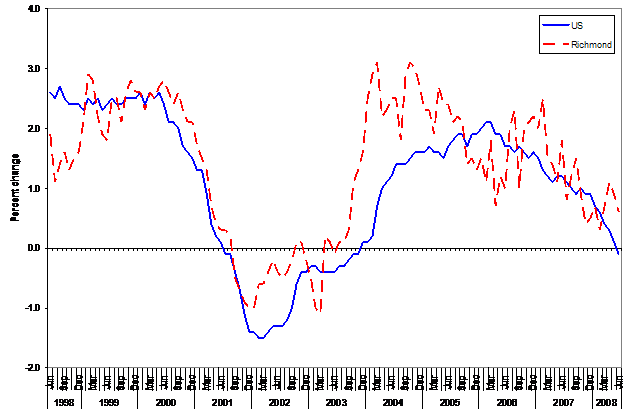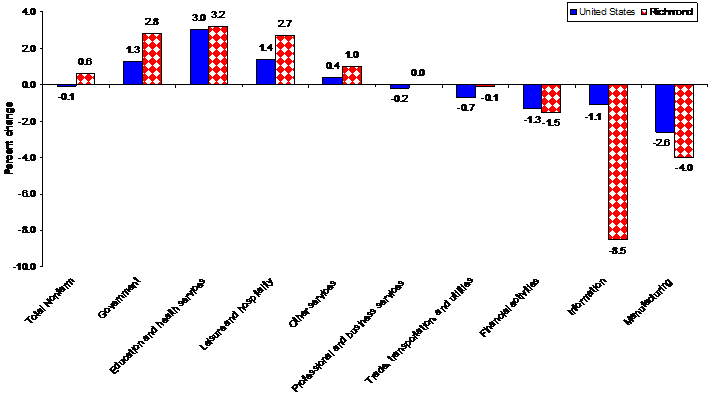| Internet: www.bls.gov/ro3/ |
|
||
| INFORMATION: | Gerald Perrins (215) 597-3282 |
||
| MEDIA CONTACT: | Sheila Watkins (215) 861-5600 |
||
June 2008 Job Count for the Richmond Area Rose Over the Year (PDF)Total nonfarm employment for the Richmond Metropolitan Statistical Area stood at 644,900 in June 2008, up 3,900 over the year, the Bureau of Labor Statistics of the U.S. Department of Labor reported today. Nonfarm employment in the Richmond area grew by 0.6 percent from June 2007 to June 2008 compared to a 0.1-percent decline in employment for the nation as a whole. Sheila Watkins, the Bureau’s regional commissioner, noted that the over-the-year employment advances in the Richmond metropolitan area extended back to July 2003—five years of uninterrupted increases in local payrolls. However, the recent advance was well below the area's peak increases of 3.1 percent posted in both March and October 2004. (See chart A and table 1; Technical Note at end of release contains metropolitan area definition. All data in this release are not seasonally adjusted; accordingly, over-the-year analysis is used throughout.) Chart A. Total nonfarm employment, over-the-year percent change in the United States and the Richmond metropolitan area, June 1998-June 2008 In the Richmond metropolitan area, the government supersector experienced the largest employment gain, adding 3,200 jobs over the year. Most of the recent increase was in the state government component, which grew by 2,400, or 5.6 percent, since June 2007. Locally, government employment increased at a 2.8-percent pace, more than twice the national average of 1.3 percent. (See chart B.) Chart B. Over-the-year percent change in employment by selected industry supersector, United States and the Richmond metropolitan area, June 2008
Two other industries in the Richmond area had job increases of at least 1,000 from June 2007 to June 2008: education and health services (2,300) and leisure and hospitality (1,500). Both industries added jobs at a faster rate in the local area than in the nation as whole. Job losses of 1,000 or more in Richmond were limited to two supersectors, manufacturing and information. Employment in manufacturing declined by 1,700 in the 12 months ended June 2008. Over-the-year employment declines in the manufacturing industry have continued uninterrupted since May 2000. The 4.0-percent decrease in Richmond was larger than the 2.6-percent decline for the nation as a whole. The information sector lost 1,000 jobs over the year, declining at a faster rate in the local area (-8.5 percent) than nationwide (-1.1 percent). Technical NoteThis release presents nonfarm payroll employment estimates from the Current Employment Statistics (CES) program. The CES survey is a Federal-State cooperative endeavor in which State employment security agencies prepare the data using concepts, definitions, and technical procedures prescribed by the Bureau of Labor Statistics. EmploymentDefinitions. Employment data refer to persons on establishment payrolls who receive pay for any part of the pay period that includes the 12th of the month. Persons are counted at their place of work rather than at their place of residence; those appearing on more than one payroll are counted on each payroll. Industries are classified on the basis of their principal activity in accordance with the 2007 version of the North American Industry Classification System. Method of estimation. The employment data are estimated using a "link relative" technique in which a ratio (link relative) of current-month employment to that of the previous month is computed from a sample of establishments reporting for both months. The estimates of employment for the current month are obtained by multiplying the estimates for the previous month by these ratios. Small-domain models are used as the official estimators for the approximately 39 percent of CES published series which have insufficient sample for direct sample-based estimates. Annual revisions. Employment estimates are adjusted annually to a complete count of jobs, called benchmarks, derived principally from tax reports that are submitted by employers who are covered under state unemployment insurance (UI) laws. The benchmark information is used to adjust the monthly estimates between the new benchmark and the preceding one and also to establish the level of employment for the new benchmark month. Thus, the benchmarking process establishes the level of employment, and the sample is used to measure the month-to-month changes in the level for the subsequent months. Reliability of the estimatesThe estimates presented in this release are based on sample survey, administrative data, and modeling and, thus, are subject to sampling and other types of errors. Sampling error is a measure of sampling variability—that is, variation that occurs by chance because a sample rather than the entire population is surveyed. Survey data also are subject to nonsampling errors, such as those which can be introduced into the data collection and processing operations. Estimates not directly derived from sample surveys are subject to additional errors resulting from the specific estimation processes used. The sums of individual items may not always equal the totals shown in the same tables because of rounding. Employment estimates. Measures of sampling error are available for state CES data at the total nonfarm and supersector level and for metropolitan area CES data. Information on recent benchmark revisions for states is available on the BLS Web site at www.bls.gov/sae/. Area definitions. The substate area data published in this release reflect the standards and definitions established by the U.S. Office of Management and Budget on November 20, 2007. A detailed list of the geographic definitions is available at www.whitehouse.gov/omb/bulletins/fy2008/b08-01.pdf. The Richmond, Va. Metropolitan Statistical Area (MSA) includes Amelia, Caroline, Charles City, Chesterfield, Cumberland, Dinwiddie, Goochland, Hanover, Henrico, King and Queen, King William, Louisa, New Kent, Powhatan, Prince George, and Sussex Counties and Colonial Heights, Hopewell, Petersburg, and Richmond cities in Virginia. Additional informationMore complete information on the technical procedures used to develop these estimates and additional data appear in Employment and Earnings, which is available by subscription from the Superintendent of Documents, U.S. Government Printing Office, Washington, DC 20402 (telephone 202-512-1800). Industry employment data for states and metropolitan areas from the CES program are also available in the above mentioned news releases and from the Internet at www.bls.gov/sae/ . For personal assistance or further information on the Current Employment Statistics program, as well as other Bureau programs, contact the Mid-Atlantic Information Office at 215-597-3282 from 8:30 a.m. to 12:00 p.m. and 1:00 p.m. to 3:30 p.m. ET. |
|||
| Area |
Back data |
Jun 2007 |
Apr 2008 |
May 2008 |
Jun 2008 (p) |
Jun 2007 to Jun 2008 (p) |
|
|---|---|---|---|---|---|---|---|
| Net change |
Percent change |
||||||
United States(1) |
|||||||
| Total nonfarm |
138,791 | 137,730 | 138,405 | 138,694 | -97 | -0.1 | |
| Natural resources and mining |
733 | 743 | 761 | 778 | 45 | 6.1 | |
| Construction |
7,913 | 7,125 | 7,306 | 7,425 | -488 | -6.2 | |
| Manufacturing |
13,990 | 13,544 | 13,567 | 13,629 | -361 | -2.6 | |
| Trade, transportation, and utilities |
26,662 | 26,274 | 26,396 | 26,478 | -184 | -0.7 | |
| Information |
3,055 | 3,003 | 3,011 | 3,022 | -33 | -1.1 | |
| Financial activities |
8,383 | 8,206 | 8,227 | 8,273 | -110 | -1.3 | |
| Professional and business services |
18,133 | 18,000 | 17,983 | 18,100 | -33 | -0.2 | |
| Education and health services |
18,137 | 18,924 | 18,868 | 18,686 | 549 | 3.0 | |
| Leisure and hospitality |
14,049 | 13,581 | 13,906 | 14,248 | 199 | 1.4 | |
| Other services |
5,573 | 5,532 | 5,553 | 5,595 | 22 | 0.4 | |
| Government |
22,163 | 22,798 | 22,827 | 22,460 | 297 | 1.3 | |
Richmond Metropolitan Statistical Area |
|||||||
Total Nonfarm |
641.0 | 637.4 | 640.5 | 644.9 | 3.9 | 0.6 | |
Natural Resources, Mining, & Construction |
47.6 | 47.0 | 47.3 | 47.7 | 0.1 | 0.2 | |
Manufacturing |
42.7 | 41.1 | 41.0 | 41.0 | -1.7 | -4.0 | |
Trade, Transportation, & Utilities |
118.4 | 118.0 | 118.2 | 118.3 | -0.1 | -0.1 | |
Information |
11.8 | 10.7 | 11.0 | 10.8 | -1.0 | -8.5 | |
Financial Activities |
46.3 | 45.1 | 45.4 | 45.6 | -0.7 | -1.5 | |
Professional & Business Services |
99.4 | 98.4 | 98.4 | 99.4 | 0.0 | 0.0 | |
Educational & Health Services |
71.8 | 74.2 | 74.1 | 74.1 | 2.3 | 3.2 | |
Leisure & Hospitality |
56.3 | 53.3 | 55.5 | 57.8 | 1.5 | 2.7 | |
Other Services |
31.5 | 31.3 | 31.5 | 31.8 | 0.3 | 1.0 | |
Government |
115.2 | 118.3 | 118.1 | 118.4 | 3.2 | 2.8 | |
Footnotes |
|||||||
Last Modified Date: August 5, 2008



